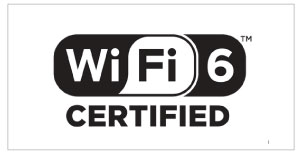WiFi 6 brings more than just high speed

WiFi 6 brings more than just high speed

The next generation standard for WiFi technology, called "WiFi 6", can also be called "AX WiFi" or “802.11ax”。 It was created to meet the exponentially growing demand for device networking, so it can also be used in VR and smart homes. It is an existing 802.11ac WiFi An upgraded version of the standard that addresses the capacity, efficiency, coverage, and performance challenges of existing technologies.

Figure 1: WiFi 6
This technology was developed in 2014 and completed in 2018 by the IEEE High Performance Wireless Network Research Group (HEW SG). Product certified in 2019 Later in the year, the Samsung Galaxy Note 10 and Ruckus R750 used this technology. WiFi 6 runs on 1GHz and 6GHz Band, the main frequency is 2.4GHz-5GHz.
Today, the average household has nine devices that require WiFi connectivity. WiFi 6 is primarily focused on improving network quality, not speeding up certain devices.
Features of WiFi 6
- Multi-user, multiple-input, multiple-output (MU-MIMO): Routers and multiple devices can communicate simultaneously. On the 2.4GHz and 5GHz frequencies, it supports four simultaneous data streams that, when added to a user, can receive a considerable bandwidth of input data from the smart router.
- 1024-QAM: This allows WiFi 6 to encode more bytes per packet and increase throughput by 25%. It not only improves the communication efficiency in the case of large traffic volume, but also maximizes the transmission rate. This has great advantages in the field of modern enterprise applications.
- Orthogonal Frequency Division Multiplexing (OFDM): Supports four times the subcarrier and is also 11% faster. The extended signal allows users to transmit more packets at the same time. As a result, the latency and latency between packets is reduced.
- Increased channel width: The 80MHz band doubles the channel width with 160MHz channel communication. As a result, routers can accommodate more users, providing a larger stream of data to each user.
- Target Wake Time (TWT): This is unique to WiFi 6. It allows each device to independently negotiate the wake times that are sent and received. It increases overall sleep time and maximizes battery life. It also supports many additional networking options, especially for IoT devices.
- Improved security: All devices that support WiFi 6 need to include the WPA3 protocol. It encrypts unauthenticated communications, provides strong password protection against brute force dictionary attacks, and 192-bit encryption of sensitive information for increased data reliability.
- Beamforming: With eight antennas, beamforming increases transmission rates and extends communication range by directing directly to a client. It supports fast-moving devices that may face multiple users, multiple inputs, and multiple outputs. Beamforming is also beneficial for controlling the transmission of antennas that deliberately emit interfering signals. The signal is then redirected to a new target.
Devices that support WiFi 6
Until now, routers, repeaters, mesh networks, and most WiFi users have used WiFi 5 as the standard. WiFi 6 was introduced in 2019. Some early devices that supported WiFi 5 had some compatibility issues — they could use WiFi 6's network, but they didn't get the corresponding support.
WiFi 6 routers are backwards compatible. You should make sure that your network is ready for this.
WiFi 6 achieves low power consumption and is a good choice for any scenario, including IoT. It reduces unnecessary data flow and also notifies the device when to activate data or put it to sleep. So unnecessary data flow is reduced, and performance and battery life are improved.
The Samsung Galaxy Note 10 and Ruckus R750 are the world's first certified WiFi 6-enabled smartphones and access devices, Apple's latest model The iPhone is also a close second. The WiFi Alliance has established a certification scheme, and as expected, new wireless products waiting to enter the market are also starting to apply for certification. The following devices are supported WiFi 6:
- iPhone 11 and later models
- Samsung Galaxy S10, S20, Note 10 and Note 20
- Apple computers configured with M1 processors
- Smart TV
In order to fully enjoy the improvements brought about by the 802.11ax standard, both hardware and software functionality needs to be upgraded based on this WiFi technology.
Hardware testing
To get the most out of the latest devices, you need a WiFi 6 Router to run the network. A few years ago, it was expensive to do so, but now we have several options, even with grid systems, gaming routers, range extenders, and much more. Only when you do actual testing, you can buy the most cost-effective equipment. Nowadays, in terms of speed, TP-Link The Archer AX6000 is the fastest, beating all the competition. This router can transmit data wirelessly at a rate of 1523 Mbps, and the effective transmission distance is 1.5 m (5 ft).
It's important to remember that these routers are not acting by magic when they speed up. A theoretical maximum rate of 9.6 Gbps is not achievable. This theoretical maximum rate is actually shared by multiple devices.
WiFi 6 focuses on providing high-quality connectivity in places where connected devices are dense. It does not increase the rate of individual devices exponentially, but it does make the associated devices operate at an ideal level.
Only the acceleration plans of major Internet Service Providers (ISPs) combined with WiFi 6 routers can realize its true potential. The real challenge is for ISPs to take advantage of this next-generation technology. There is an important question: as ISP communication rates become faster, will existing hardware become redundant?
Application of WiFi 6
- Large Public Spaces (LPVs): Stadiums and convention centers are public places where thousands of devices are connected at the same time. WiFi 6 improves the attendee experience, enhances consumer engagement, and provides additional services such as instant replay, ordering meals, and more. It also supports LPV owners in pioneering new business opportunities.
- Transportation hubs: Public transportation stations are also places where people need to be connected at the same time. Technologies such as OFDMA and BSS, which have a clear WiFi 6 color, provide the necessary tools to solve this problem.
- Internet of Things and Smart City Construction: The energy efficiency of WiFi 6 allows IoT devices to enter sleep mode and turn on transmitters at predetermined intervals to increase on-site hours without much maintenance.
- Educational institutions: Libraries, auditoriums, and lecture halls on university campuses have the highest density of WiFi usage during the day, with almost no people at night. WiFi 6 is the perfect choice for these types of scenarios.
(LCTT Translation: Related Product Recommendations section abridged.) )
Challenges
WiFi 6 doesn't necessarily make speeds faster, but it ensures that device speeds within range won't slow down in the coming years. While it faces triple challenges, these issues are often overlooked.
- Unsupported devices need to be upgraded: Even if Wifi 6 is backwards compatible, it can only be done reasonably if the technology is used to the maximum. This means updating the device every time.
- Speed and performance outside the internal network: WiFi 6 provides excellent connectivity for services such as cloud file sharing. However, the resources associated with the ISP can also affect speed and performance.
- Coverage issues: In each country, the transmission of signals and bandwidth is capped by law. Therefore, WiFi 6's coverage is also limited in order to comply with the legal cap.
Despite these challenges, some businesses, like Aruba, Asus, AT&T, Boingo, Broadcom, Cisco, Comcast, CommScope, Cypress, Extreme Networks, Intel, Netgear, Orange, Qualcomm, TP-Link and Xiaomi are all eyeing more possibilities with WiFi 6.